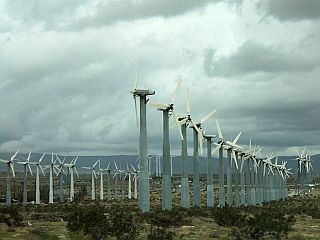 Planet Gore posted an item today about wind turbine wake (‘propwash’) causing turbines downwind to have reduced output because of the turbulent air generated by upwind turbines.
Planet Gore posted an item today about wind turbine wake (‘propwash’) causing turbines downwind to have reduced output because of the turbulent air generated by upwind turbines.
Image: Wind Turbines In Banning Pass. One of the largest wind turbine farms in the world is here near Palm Springs, CA. Photo courtesy Damsel. Click to enlarge.
I have always been skeptical about the reliability, efficiency and cost-per-generated-kilowatt of wind turbines. We recently were on a road trip and saw two different convoys of trucks carrying the estimated fifty foot long blades either to a new installation or to maintenance. I couldn’t believe the way the immense turbine blades dwarfed the big-rig tractors hauling them.
From Popular Science.
Downstream wind turbines may lose 20 percent or even 30 percent of their power compared to their fellows in front, according to a study on wake effects at Horns Rev that MacKay highlights on his blog. The paper also emphasizes that different wind directions make it practically impossible to gauge an overall “steady state” for large wind farms, unless researchers can sample wind speeds and directions at multiple points throughout the array.
This shows that wind energy may represent a highly visible form of alternative energy, but certainly not one without its quirks and controversies. Still, better technology can squeeze more juice out of each gust, and cooperative energy-sharing efforts can help offset the fickle nature of wind power.

I saw the same thing on I-95 in Pennsylvania. I could not believe the size of those blades.
My brother is involved in amateur aviation and states that jets have to stay at least five miles behind other jets in order not to be affected by the disturbance coming off the wing tips. Not the engines – the tips of the wings. This turbulence is incredibly strong and can cause small craft to completely lose control.
I saw some on a convoy of trailers coming out of Long Beach harbor a couple of weeks ago. Don’t know where they were headed, but they sure had traffic in knots.
As far as wake turbulence goes….just another DUH!
As sig notes, any small aircraft pilot can tell you horror stories about the wing top vortices generated by a large aircraft.
Regarding the wake turbulence – I inadvertently flew a twin Bonanza (“T-bone,” as we used to call it) across the wingtip vortices of a C-130 Hercules – not an extremely big aircraft. We crossed the wake at roughly right angles, so the turbulence was brief, but put everything in the cockpit not tied down on the overhead for a moment before slamming it all back down.
Sphincter control in such an event is critical.
Sphincter Control, this is T-Bone… we have a problem.
LOL!
ARTCC: Anal-Rectal Traffic Control Center (as opposed to Air Route TCC). Piloting that ol’ T-Bone was hours and hours of boredom punctuated with fleeting moments of sheer terror.